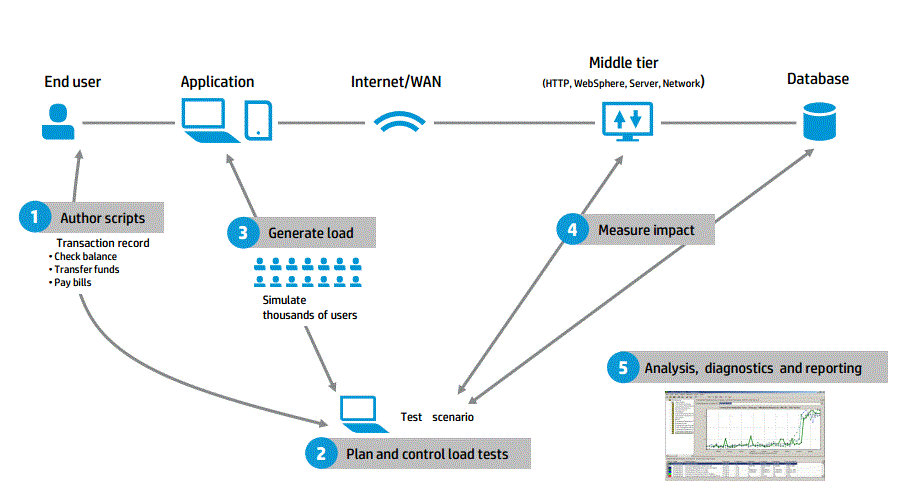Load Runner Introduction
Load Runner is performances testing tool which is widely used for load, stress, volume and soak testing. Load runner supports maximum client server protocol for performance testing e.g HTTP/HTML, SAP, Citrix ect. Load runner is best tool for Web and SAP application.Architecture of Load Runner:
Load runner is GUI based tool and very user friendly, basically it have five components:
1. Virtual User Generator (VuGen): VuGen is first component of load runner which is used for script creation, verification, modification. It allow user to record application flow which needs to test for load testing , it also allow user to put check points, data parameterization, think time, pacing which helps in record real user behavior on application and Reply it for load testing..
2. Controller: it is second component of LR which is used to generated x number of user load on application. controller is also used to monitor the web, App and database server during load testing, it allow user to add multiple graph such as Response time graph, Recourse monitor (used to monitor any window or Linux machine), throughput, hits par second etc.
3. Load Generator (LG): LG are used to generate load from specific location or geography, user can use multiple LG in controller.
4. Agent Process: This is window services which is running on Load Generator machine and helps in communication between controller and load generator.
5. Analysis: This component of LR is used to generate performances report. One’s user has completed execution in controller Analysis is used to generate performances report in various format e.g HTML, Excel, Word PDF or user define format. It also allow user to add or merger multiple graph and filtering the graph based on user criteria.
File Extensions in Load runner
VuGen: .USR is the file extension.
Controller : .lrs is the file extension
Result: .lrr result generated by Controller
Analysis : .lra is the file extension

Why Load Runner?
• Load runner is the tool which is dominating in Performances testing market almost 85% of Performances testing done by Load runner.
• LoadRunner reduces the personnel requirements by replacing human users with virtual users or Vusers.These Vusers emulate the behavior of real users-- operating real applications.
• Because numerous Vusers can run on a single computer, LoadRunner reduces the hardware requirements.
• Because LoadRunner tests are fully automated, you can easily repeat them as often as you need.
• LoadRunner checks where performance delays occur: network or client delays, CPU performance, I/O delays, database locking, or other issues at the database server. LoadRunner monitors the network and server resources to help you improve performance.
• LoadRunner automatically records the performance of the client/server system during a test. You can choose from a wide variety of graphs and reports how you want to view the performance data.
• The LoadRunner Controller allows you to easily and effectively control all the Vusers--from a single point of control.
FIND MORE ON LOAD RUNNER TIPS
| About Load Runner | Creating scripts in Load Runner | Load Runner scenario | LR Analysis | Performance Tuning | Performance Testing | LR Errors | Interview Question | Load Runner Tool | Correlation Practice | Site Map |
| About Load Runner | Creating scripts in Load Runner | Load Runner scenario | LR Analysis | Performance Tuning | Performance Testing | LR Errors | Interview Question | Load Runner Tool | Correlation Practice | Site Map |